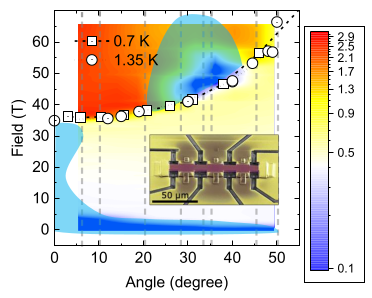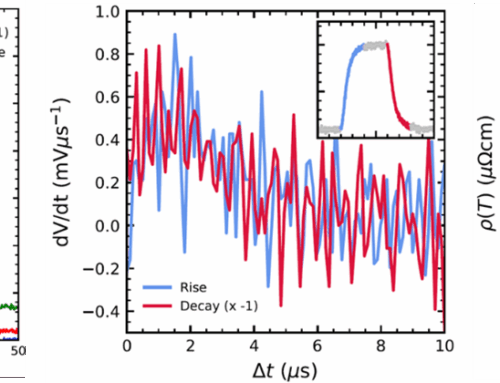Toni Helm, HLD.
The recent discovery of superconductivity (SC) in the heavy-fermion metal UTe2 with a critical temperature of about 2 K triggered much excitement, as its critical field reaches values approaching those of high-Tc superconductors. Moreover, UTe2 appeared very quickly as a potential candidate for topological spin-triplet SC that exhibits multiple unconventional superconducting phases under field or pressure. Spin-triplet SC is a rare phenomenon, expected to arise as a consequence of magnetic fluctuations in strongly correlated materials. It is characterized by a particularly high stability against external magnetic fields, since the Zeeman energy has no influence on the Cooper pairing. Indeed, a key characteristic of UTe2 is an anisotropic upper critical field that exceeds the so-called Pauli limit along all field orientations.
For field aligned along the b axis, SC survives up to a metamagnetic transition at µ0Hm ≈ 35 T. The latter is associated with magnetic fluctuations that may be beneficial for the field-reinforced superconductivity surviving up to Hm. Once the field is tilted away from the b towards the c axis, a reentrant superconducting phase emerges just above Hm (see the phase diagram in Figure 1). In order to understand this remarkably field-resistant superconducting phase, an EMFL team together with researchers from Germany, France, and Japan conducted magnetic-torque and magnetotransport measurements in pulsed magnetic fields. They determined the record-breaking upper critical field of μ0Hc2 ≈ 73 T and its evolution with angle. In their electrical-transport studies, they revealed that the normal-state Hall effect experiences a drastic suppression upon tilting the field away from the hard magnetic b axis. The minimum in the Hall effect is correlated with the maximum of Hc2 of the high-field SC, as shown in Figure 2. This hints at a reduced band polarization above Hm in the angular range around 30° caused by a partial compensation between the applied field and an internal exchange field. This promotes the Jaccarino-Peter effect as a likely mechanism for the appearance of reentrant superconductivity above Hm.
These results provide a guide for future experiments and theory that will show more quantitatively if and how reentrant SC may appear. Such a scenario puts specific constraints on the potential order parameter of the superconducting phase. Solving the riddle of how Cooper pairs, built by heavy quasiparticles, can survive in extreme magnetic fields will certainly help advance our fundamental understanding of unconventional superconductors.

Figure 1: Contour plot created from magnetoresistance data (the color bar corresponds to the resistance in ohm). White squares and circles mark the metamagnetic transition field measured by pulsed-field torque magnetometry. Blue shaded regions indicate the superconducting phases. Inset: Microstructure fabricated from single crystals by focused-ion-beam patterning.

Figure 2: Angular dependence of the normal-state Hall resistivity at 65 T and 0.7 K of two microstructure devices. The blue dashed line is a guide to the eye that highlights the observed strong suppression around 30 – 35°. Green diamonds are Hc2 values extrapolated to zero temperature. The red dashed line follows cos θ.
Field-induced compensation of magnetic exchange as the possible origin of reentrant superconductivity in UTe2, T. Helm, M. Kimata, K. Sudo, A. Miyata, J. Stirnat, T. Förster, J. Hornung, M. König, I. Sheikin, A. Pourret, G. Lapertot, D. Aoki, G. Knebel, J. Wosnitza, and J.-P. Brison, Nat. Commun. 15, 37 (2024).
https://www.nature.com/articles/s41467-023-44183-1
Contact: t.helm@hzdr.de






